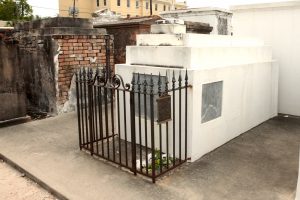Visit to St. Louis Cemeteries 1 & 2
I enjoyed a tour of the St. Louis Cemeteries 1 & 2 today in New Orleans. It was really neat to see in these old cemeteries the names of those who served with Jean Baptiste Lapaise de Vedrines in the French Marines or their ancestors, like de Moncharvaux, de Villiers, de Martingy, etc. One of those tombs was Etienne de Boré.
to see in these old cemeteries the names of those who served with Jean Baptiste Lapaise de Vedrines in the French Marines or their ancestors, like de Moncharvaux, de Villiers, de Martingy, etc. One of those tombs was Etienne de Boré.
Jean Étienne de Boré (27 December 1741 – 1 February 1820) was born to French parents, Louis de Boré and Celeste Therese de Boré in Kaskaskia, Illinois Country. His parents sent him to France to be educated. He spent most of his life there. On leaving school he entered French military service in the Musketeers of the Guard, which was part of the royal household and very prestigious.
After a visit to Louisiana on business, he was transferred to the cavalry. Boré left the army with the rank of captain.
with the rank of captain.
He married Marie Marguerite d’Estrehan, of one of the most prominent families of colonial Louisiana. Her father Jean Baptiste d’Estrehan was the Royal Treasurer of French Louisiana and worked from Paris.
Boré owned a great plantation a few miles upriver of New Orleans on the Mississippi River, in the vicinity of New Orleans’ Audubon Park. There he had originally cultivated indigo. But when this product lost its market as a result of competition from Guatemala, he converted his fields to sugar cane. On his plantation, he set up a sugar mill. In 1795, with the aid of two Cubans, Mendez and Lopez, he produced the first granulated sugar known in the colony. This created a huge demand for the cultivation and processing of sugar cane. Responding to the worldwide demand for sugar, it became the colony’s primary commodity crop. Louisiana began to generate profits.
After the United States acquired the Louisiana Purchase territory, Boré was appointed, in late 1803, as the first mayor of New Orleans by the Governor of the Orleans Territory, William C. C. Claiborne. (Boré’s service to the city began during the transitional French governorship of Pierre Clément de Laussat.) Boré resigned in May 1804, to look after his personal affairs.
He died at about eighty years old and was interred in New Orleans’ Saint Louis Cemetery No. 1. One of his grandchildren, Charles Gayarré, became a noted historian of Louisiana later in the 19th century.
New Orleans has a Boré Street, in honor of the first Mayor.
